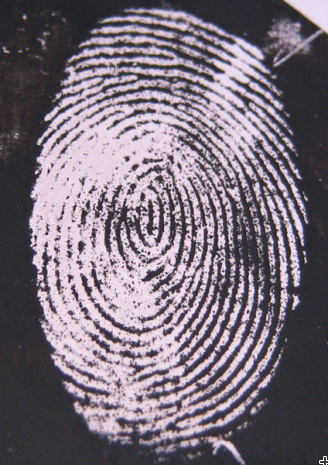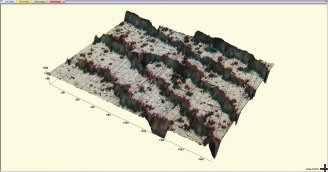Copyright 2012 neutronsources.org | All rights reserved. | Powered by FRM II | Imprint / Privacy Policy
New fluorescent fingerprint tag aims to increase IDs from ‘hidden’ fingerprints on bullets and knives
03.07.2013
- Neutron scattering at ILL and ISIS delves inside new crime scene forensics technique developed by the University of Leicester
- Research to address the fact that only 10% of fingerprints taken from crime scenes yield identifications that are usable in court
A new way of detecting and visualizing fingerprints from crime scenes using colour-changing fluorescent films could lead to higher confidence identifications from latent (hidden) fingerprints on knives, guns, bullet casings and other metal surfaces. The technique is the result of a collaboration between the University of Leicester, the Institut Laue-Langevin and the STFC’s ISIS pulsed neutron and muon source, and will be presented today at the Royal Society of Chemistry’s Faraday Discussion in Durham.
When your finger touches a surface, it leaves behind deposits of sweat and natural oils in a pattern that mirrors the ridges and troughs found on your fingertips. The odds of two individuals having identical fingerprints are 64 billion to 1, making them an ideal tool for identification in criminal investigations.
The greatest source of fingerprint forensic evidence comes from latent fingerprints, i.e. those not immediately visible to the eye, because they are less likely to be ‘wiped’. However, visualizing these prints with sufficient clarity for positive identification often proves difficult. Despite the availability of several enhancement techniques, only 10% of fingerprints taken from crime scenes are of sufficient quality to be used in court.
The classical approach to enhance latent print visibility is to apply a coloured powder that adheres to the sticky residue and provides a visual contrast to the underlying surface. However, these techniques require significant preservation of fingerprint material and are therefore vulnerable to ageing, environmental exposure or attempted washing of the fingerprint residue.
To address this, researchers from the University of Leicester have been working on a new technique that visualizes fingerprints by exploiting their electrically insulating characteristics. Here, the fingerprint material acts like a mask or stencil, blocking an electric current that is used to deposit a coloured electro-active film. This directs the coloured film to the regions of bare surface between the fingerprint deposits, thereby creating a negative image of the print. Unlike conventional fingerprint visualization reagents, the polymers used by the University of Leicester researchers are electrochromic, that is to say they change from one colour to another when subjected to an electrical voltage.
The technique is highly sensitive as even tiny amounts of insulating residue, just a few nanometres thick, can prevent polymer deposition on the metal below. As a result, much less fingerprint residue is required than is typical for other techniques. Also, because it focuses on the gaps between the fingerprint deposits, it can be used in combination with existing (e.g. powder-based) approaches.
In their latest paper in Faraday Discussions the team, led by Professor Robert Hillman, have developed this technique further by incorporating within the film fluorophore molecules that re-emit light of a third colour when exposed to light or any other form of electromagnetic radiation such as ultra-violet rays. Their success in combining the electrochromic and fluorescence approaches provides a significantly wider palette to ‘colour’ their films and two sets of ‘levers’ in the form of electricity and light to control and tune this colouration in order to achieve the best possible contrast with the underlying metal surface.
The addition of these large fluorescent tagging molecules required a conducting film that could undergo post-deposition chemical changes. Neutron reflectivity measurements were used to follow and quantify the deposition and functionalisation of the film with the fluorophores. These measurements were performed on FIGARO and D17 at the Institut Laue-Langevin (Grenoble, France) and on INTER at ISIS (STFC Rutherford Appleton Laboratory in the UK).
The exact position and distribution of the fluorophores within the film is key. Professor Hillman and colleagues needed the molecules to penetrate the deposited polymer layer without reaching the underlying metal surface, where their fluorescence is diminished. Using isotopic methods, the team were able to use neutrons at ILL and ISIS to label the different parts of the system and observe the behaviour of each to find the ideal conditions (temperature, polymer concentrations, reaction time) for the introduction of the fluorophores.
Using the new technique on laboratory-sourced fingerprints, Professor Hillman and colleagues have already demonstrated an improved ability to make positive identifications due to better sample resolution. However the team are keen to stress these prints were taken under laboratory conditions. The next step is to apply it to fingerprints that have been exposed to more realistic scenarios, such as water, heat from a fire or cleaning agents.
Quotes
Professor Robert Hillman said: “By using the insulating properties of the fingerprints to define their unique patterns and improving the visual resolution through these colour-controllable films, we can dramatically improve the accuracy of crime scene fingerprint forensics. From the images we have produced so far, we are achieving identification with high confidence using commonly accepted standards. This combination of optical absorption analysis with observation based on fluorescence is also opening up fingerprint analysis to a far wider set of samples, particularly those eroded by ageing or aggressive environments. The use of neutrons alongside spectroscopic techniques has been fundamental to understanding how this technique might work in practice and is evidence for what has been a truly collaborative partnership between these three institutions.”
Dr Rob Barker, Instrument Scientist at the Institut Laue-Langevin, said: “Neutrons are an ideal tool for understanding what is going on inside these complex systems. Whilst the mix of polymer and fluorescent molecules might look similar to x-rays and other surface-sensitive techniques, neutrons can easily distinguish between them. This allowed us to non-invasively probe on a nanometre scale deep into the sample from the top surface of the polymer to the metal below and follow the marker molecules as they entered the polymer film.”
Dr Max Skoda, Instrument Scientist at ISIS said: “The newest neutron reflection instruments, built at both ISIS and the ILL, provide high intensity beams that enable the real time study of changes in such complex systems for the first time. In order to unravel the intricate behaviour of these chemical reactions it was necessary to employ the specialist skills and facilities provided by all the institutes involved. This is a clear example of where investment in new world class scientific capability continues to provide tools for the UK academic community to perform world leading science.
Access to both the ILL and ISIS is provided to UK researchers by funding from the Science and Technology Facilities Council, STFC, which also operates the ISIS neutron source.
This week the governments of France, Germany and the UK agreed to continue inter-governmental support for the Institut Laue-Langevin for at least the next 10 years, until 2023.
Original Publication: Faraday discussions, DOI 10.1039/C3FD00053B
Contact: James Romero, james@proofcommunication.com / +44 8456801866
Notes to editors
- Fingerprint patterns fall into three basic categories. First-level details include loops, whorls and arches. While these can clearly eliminate certain individuals, positive identification relies on the minutiae (or second-level detail) within the pattern: these include features such as ridge endings, crossovers (bridges), short independent ridges, islands, bifurcations, spurs, dots and lakes. There are also finer features (third level detail) present in a fingerprint image: these include the detailed shapes of the ridges and individual sweat pores. While not currently used in fingerprint identification, there is considerable research interest in third level detail, since it may in future permit analysis of smaller fragments of marks left by a finger, i.e. partial fingerprints.
- Selection of film and insertion of fluorophores – Polypyrrole, long chains of the organic molecule pyrrole, commonly found in electronic devices due to its conductive properties, was chosen for the film. To this the team added the fluorescent, Dylight 649 NHS ester, commonly used to label antibodies and other proteins for cellular imaging. This, however, proved a challenging process. The large fluorophore molecules destabilised the film if added to the pyrrole molecules before they were turned into long polymer chains. Instead the team added a smaller molecule (ester-bound fluorenylmethyloxycarbonyl) which could easily be removed post-deposition through hydrolysis, leaving behind holes that aggregate over time to a size where they can accommodate the larger fluorophores.
- About ILL – The Institut Laue-Langevin (ILL) is an international research centre based in Grenoble, France. It has led the world in neutron-scattering science and technology for almost 40 years, since experiments began in 1972. ILL operates one of the most intense neutron sources in the world, feeding beams of neutrons to a suite of 40 high-performance instruments that are constantly upgraded. Each year 1,200 researchers from over 40 countries visit ILL to conduct research into condensed matter physics, (green) chemistry, biology, nuclear physics, and materials science. The UK, along with France and Germany is an associate and major funder of the ILL.

